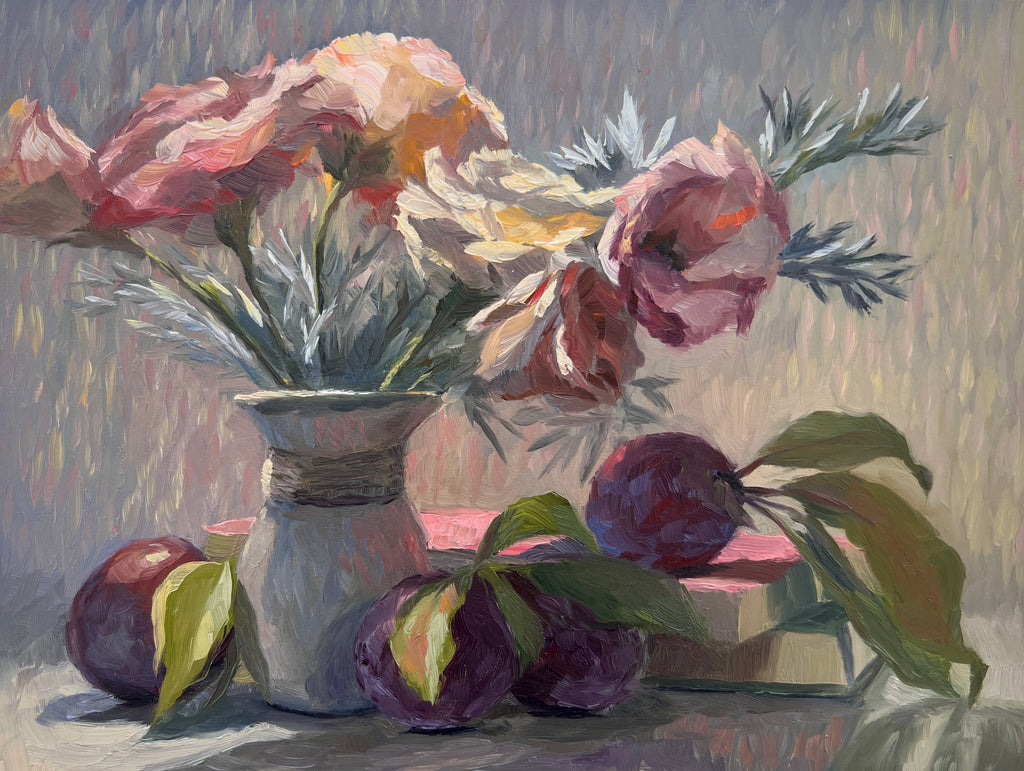What to Take into consideration in Selecting the Perfect Oil Paintings for Your Home Design

Recognizing Your Individual Style
Comprehending one's individual design is necessary when choosing oil paints for home decoration. Individuals have to initially assess their preferences, thinking about aspects such as color, motif, and psychological vibration. Some may gravitate in the direction of vibrant abstract pieces that evoke power, while others may prefer serene landscapes that promote harmony. Identifying whether one leans towards modern-day minimalism or traditional realistic look can guide the choice procedure. Additionally, personal design often mirrors cultural impacts, experiences, and imaginative tastes, making it essential to select pieces that resonate deeply. By aligning their selections with their distinct visual, people produce a cohesive ambience that improves their space, eventually resulting in a home that personifies their character and worths via art.
Considering the Dimension and Scale
Size and scale play an important duty in the effective combination of oil paints into home decoration. Picking the ideal measurements guarantees that artworks complement the room as opposed to overwhelm or underwhelm it (oil paintings for sale). For larger areas, substantial paintings can work as centerpieces, including depth and interest. On the other hand, smaller sized artworks can boost cozy areas without creating mess. When determining on dimensions; a well-placed paint can develop harmony and balance in a room, it is essential to take into account wall area and furniture setup. Additionally, grouping smaller items can create a natural gallery result, while a solitary huge canvas may stand alone as a statement item. Eventually, the chosen dimension and scale need to mirror the total layout intent of the home
Picking the Right Shade Palette
Selecting the appropriate shade combination for oil paintings is crucial to boost a home's style. It not just matches existing furnishings but additionally establishes the wanted state of mind for each room. Furthermore, the impacts of lights can greatly affect just how colors are perceived, making mindful factor to consider secret.
Complement Existing Decor
An unified color palette can change a room, making oil paintings a suitable option for enhancing home style. When choosing art work, it is crucial to consider the existing colors in the area. A painting that matches or contrasts the leading shades can develop aesthetic rate of interest. As an example, if an area features soft blues and whites, an oil paint with similar tones can unify the design, while a bold, contrasting item can work as a focal point. In addition, recognizing the touches in the area's color pattern-- whether trendy or cozy-- can guide the option of artwork. Eventually, the appropriate oil paint ought to improve the overall visual, creating a natural and welcoming setting that mirrors the house owner's individual design.
Establish the State of mind
Selecting the best color combination for oil paintings can considerably influence the mood of a space. Cozy colors, such as oranges and reds, have a tendency to develop a welcoming and energetic ambience, making them perfect for social spaces like living rooms. In comparison, cool tones, such as blues and eco-friendlies, advertise peace and relaxation, ideal for bed rooms or checking out spaces. Neutral shades, consisting of grays and browns, can provide a sophisticated backdrop, enabling other aspects to radiate. In addition, considering the psychological effect of particular colors is vital; for circumstances, yellow can stimulate joy, while darker tones can infuse a feeling of dramatization. Eventually, choosing a color palette that lines up with the preferred atmosphere will enhance the total design and personal expression within the home.
Take Into Consideration Illumination Impacts
When curating a home design scheme, the impact of lights on the assumption of oil paintings can not be overlooked. Natural light, for circumstances, can substantially alter the tones and appearances of an artwork, boosting its vibrancy or muting its tones. On the other hand, fabricated illumination can produce shadows or highlights that may either enhance or detract from the painting's general impact. Therefore, home owners must think about the intensity and kind of light in a room when choosing oil paints. Cozy lights can improve earthy shade combinations, while cooler lighting may match much more lively, contemporary art. Ultimately, comprehending how various lighting impacts shade understanding is essential in selecting the appropriate oil paintings that integrate with a room's atmosphere and visual goals.
Picking a Theme or Subject
When selecting a style or subject matter for oil paintings, individual style preferences play an essential role in making sure that the artwork reverberates with the property owner. In addition, considering the performance of each area can direct choices that boost the total setting. Finally, preserving consistency with the existing color combination is crucial for producing a natural and welcoming room.
Personal Style Preference
Individual style choice plays an essential role in choosing oil paintings that boost home style. Individuals typically incline certain themes or subject matters that resonate with their characters and tastes. A person with a propensity for nature might choose landscapes, while someone drawn to metropolitan life may choose cityscapes. Abstract art can attract those that appreciate modern aesthetics, while standard still lifes may draw in reactionaries. The selected art work should show the homeowner's identity, developing a cohesive environment. In addition, shade schemes and psychological tones of the paintings can greatly influence the space, adding to a preferred setting. Ultimately, aligning the art work with personal style choices guarantees that the picked oil paintings act as meaningful focal factors in the home.
Room Capability Factor To Consider
How can room capability affect the choice of oil paints? The function of a room plays an essential function in figuring out the suitable motif or subject for oil paints. In a tranquil bedroom, soothing landscapes or abstract pieces can stimulate tranquility and leisure. Conversely, in a vibrant living-room, dynamic and lively artworks may improve the energised environment. Eating locations can benefit from still-life or food-related paints, which can boost conversation and appetite. Furthermore, the choice of art work must straighten with the tasks occurring in the room; as an example, motivational items in an office can motivate performance. Eventually, selecting paintings that reverberate with the area's feature guarantees a harmonious and welcoming atmosphere.
Color Palette Consistency
A natural shade scheme is important for selecting oil paints that enhance the overall decor of a home. When selecting art work, individuals ought to think about the existing shades within the room, consisting of wall surface tones, furniture, and devices. Paintings that complement or contrast harmoniously with these components can elevate the aesthetic charm of a space. In addition, picking a theme or subject that resonates with the house owner's personal design produces a much more welcoming atmosphere. For instance, peaceful landscapes might fit a calming retreat, while dynamic abstracts could energize a lively gathering space. Eventually, the best combination of shade and style warranties that the art work not only fits within the design but also adds to a linked and meaningful home setting.
Examining the Emotional Impact
What sensations do specific oil paintings stimulate in a viewer's room? The psychological impact of an art work can substantially affect the ambiance of a room. Lively shades and dynamic brush strokes might influence power and creativity, while softer tones and peaceful landscapes can evoke harmony and calmness. Abstract pieces frequently motivate self-questioning, welcoming audiences to analyze the emotions communicated. Additionally, the topic plays a vital duty; portraits can impart connection, while nature scenes may cultivate a feeling of tranquility. Customers might likewise locate nostalgia in art work that mirrors personal experiences or memories. Inevitably, selecting oil paints that resonate psychologically can transform a living environment, producing an area that really feels authentic and welcoming to its citizens.
Finding the Perfect Placement
Where in a home can oil paints best boost the total aesthetic? Placement is substantial for making best use of the effect of oil paints. In living areas, large pieces can act as prime focus above fireplaces or sofas, attracting focus and sparking conversation. Hallways and entrances profit from smaller sized, grouped works, developing an inviting ambience. In bedrooms, softer, serene landscapes or abstracts can promote leisure when hung over the bed. Eating locations can include vibrant pieces that promote cravings and conversation. It is very important to think about lights; all-natural light can modify the paint's look, so position art work where they get ideal lighting. Inevitably, thoughtful positioning can boost the mood and cohesiveness of a room, making the art work a fundamental component of the home's style.
Budgeting for Your Art work
Developing a budget for art work is crucial for anybody wanting to enhance their home design. It helps to define financial borders, making certain that the option procedure remains enjoyable and sensible. Possible purchasers need to consider their overall spending ability, consisting of costs for mounting, installation, and maintenance. Investigating various price ranges for oil paints can additionally give beneficial understandings right into what to anticipate. Additionally, people might intend to prioritize their preferences, whether they are drawn to arising artists or developed names, as this will substantially affect rates. By setting a clear budget, art fanatics can concentrate on finding items that not only reverberate with their aesthetic yet likewise line up with their financial objectives, resulting in a fulfilling acquisition experience.
Frequently Asked Inquiries
Just how Do I Preserve and Take Care Of Oil Paintings?
Caring and maintaining for oil paints involves maintaining them in a steady environment, preventing direct sunshine, cleaning delicately with a soft cloth, and sometimes seeking advice from a professional conservator for cleaning or remediation requirements.
Can Oil Paintings Be Hung in Humid Locations?
Oil paintings can be awaited moist areas, yet caution is advised. Excess moisture might trigger paint to deteriorate or canvas to warp. Appropriate air flow and environment control can help alleviate potential damages over time.
What Is the Distinction In Between Original Art and Prints?

Exactly how Do I Pick a Frame for My Oil Paint?
Choosing a framework for an oil paint involves taking into consideration the artwork's style, shade palette, and dimension. A well-selected frame improves the piece, complementing its aesthetic while shielding it from damage and including in its discussion.
Exist Specific Artists Known for Home Decoration Oil Paintings?
Lots of musicians concentrate on oil paints appropriate for home style, including Claude Monet for impressionistic landscapes, Gustav Klimt for ornamental concepts, and Georgia O'Keeffe for dynamic flower compositions, each offering distinct designs to boost interior spaces. Comprehending one's individual design is vital when choosing oil paints for home style. Selecting the right color combination for oil paintings is crucial to boost a home's decor. A harmonious color palette can transform an area, making oil paints an optimal option for boosting home style. Personal design preference plays a crucial role in selecting oil paintings that enhance home decor. A cohesive color scheme more info is necessary for picking oil paintings that boost the general decoration of a home.
Comments on “Stylish Design Inspirations with Oil Paintings for Sale”